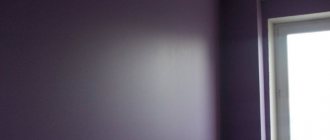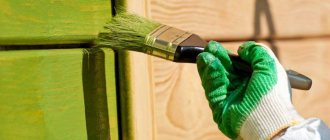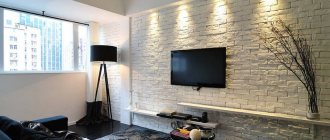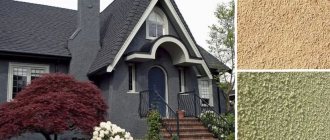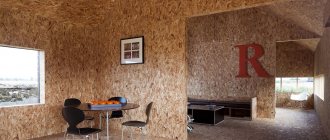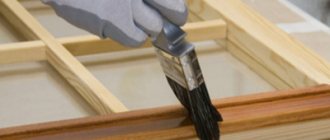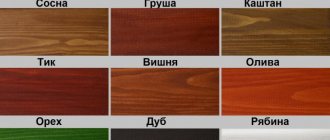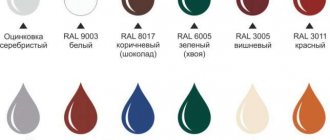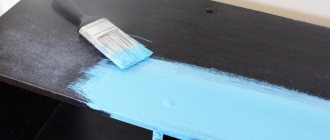One of the inexpensive and practical options to make your home more beautiful, refresh it and protect it from external negative factors is painting. This type of decorative finishing has been known since ancient times and has not lost its popularity. On the contrary, over time the coloring matter improved and could withstand the negative influence of the external environment. This is how façade paint for exterior use was created.
Unlike compositions for internal use, it is able to provide better protection, has a long service life and can withstand the constant influence of precipitation, wind, and ultraviolet rays. To paint the outside of your home, you need to choose one type of paint and get to work.
Benefits of use
Facade paints applied over plaster for exterior work improve the external characteristics of the building and create a protective layer from the effects of climatic conditions.
High-quality compositions have numerous advantages:
- resistance to damp environments. The paint does not allow water to penetrate into the wall material, protects the surface from dampness, prolonging its service life;
- good vapor permeability. The finishing layer allows air to pass through, helping moisture trapped in the walls to evaporate, oxygen penetrates into the room, refreshing the air inside;
- the paint does not deteriorate under the influence of precipitation and temperature changes, and retains the attractive appearance of the walls;
- the material for the facade of the house prevents the formation of a favorable environment for the emergence and development of microorganisms, mold and mildew.
Function of plaster paint
Facade paints are increasingly used as a decorative finishing for plastered facades. They perform not only an aesthetic role, but also protect the surface covered with plaster. The protective layer works most effectively if the facade paint on plaster is characterized by:
- resistance to UV rays of the sun;
- as high quality material;
- reliable coverage;
- environmentally friendly composition.
Manufacturers develop and produce facade dyes to perform two tasks:
- creating an attractive and original appearance of the facade;
- protection of the plaster layer on the surface from destruction under the influence of atmospheric phenomena and from temperature fluctuations.
Mineral types of paints for facades
Silicate paint for facade plastering work
If you are not interested in bright and saturated shades, you should pay attention to silicate paints, which are slightly cheaper than acrylic and are quite affordable. These compositions are based on liquid glass, contain calcium borate, as well as alkali-resistant additives, therefore they are produced only in light and light shades, because saturated dyes simply give a dirty tint and that’s all
They perfectly penetrate the plaster, cover any cracks and prevent the appearance of new ones.
- One of the main advantages of such coatings is their good permeability to gases, due to which the walls will “breathe”.
- Silicate paints are resistant to moisture, they do not allow walls to become damp and prematurely collapse.
- The high fire resistance of the coating is also a definite plus.
Among the disadvantages is the low resistance of such silicate paints to ultraviolet radiation, which means that over time the painted surface can fade significantly. Applying paint is quite difficult, and low adhesion implies mandatory preliminary preparation of the plaster and the application of a special primer.
Lime façade paints
Quite common paints for facades covered with plaster are those made on the basis of slaked lime, as well as those diluted with appropriate colors. They can be sold either completely ready for use or in a paste-like consistency. Before painting the facade, the second option must be diluted with water.
- Outstanding antiseptic properties attract many consumers to such paints.
- Lime paints are not afraid of temperature changes.
- Thanks to their special composition, mortars based on slaked lime allow the walls to “breathe”.
With all the positive qualities available, when figuring out what paint to paint a facade on plaster, lime compositions cannot be called the best, due to a large number of shortcomings. Such paint on the facade will not last longer than one year, after which it may begin to peel off if natural table salt or drying oil is not added when painting, and it becomes excessively dirty, after which it is impossible to wash it. They are afraid of moisture and have a small range of colors. But the price fully compensates for all the shortcomings, although you will have to work hard to repaint the house every year.
Cement paint for plastered walls
Another fairly well-known and popular type of mineral dyes for facades is cement-based compositions. They have one significant advantage over all others, this is hardening upon contact with water, which makes it possible to use them even in abnormally wet areas. Cement paints are suitable for painting facades, but they are definitely not suitable for wood or metal.
Such coatings have excellent vapor-permeable properties, as well as resistance to a wide variety of precipitation. Such paints do not differ in a wide range of shades; they are mainly gray and beige tones. Cement mortars are very fragile and often cannot withstand even weak mechanical stress.
How to paint the facade of a house after plastering
Paint for a plastered brick wall must have a high vapor permeability parameter. Porosity and resistance to alkaline environments are important for concrete.
Cover the wooden surface with moisture-resistant and elastic paint; however, a moisture-resistant and vapor-permeable material is suitable for any plastered base.
For plastered, wooden or concrete walls with obvious cracks, it is better to take crack-resistant rubber paint - it will perfectly hide defects or prevent their appearance.
There is a rule derived from experience: what kind of plaster base, what kind of paint base suits it. In addition, silicone or silicate CMs are suitable for lime-cement coatings; almost all types of paints are suitable for cement or lime-cement compositions.
Acrylic
Thanks to polymer compounds based on acrylic, it forms an elastic film resistant to mechanical stress. Resists bioaggressors, UV rays, as well as the formation of cracks due to microdeformations of walls. It is hydrophobic, but vapor permeable, which is important for wooden walls under plaster.
Manufacturers produce acrylic CM on organic (can be painted at temperatures down to -15°C) or water-dispersed bases. The most economical option for painting the facade. It fits well on various types of plasters, holds tenaciously, wears slightly, and is washable. Serves for more than 7 years.
Do not use over lime plaster coatings.
Silicone
The most “rubbery” is tensile paint. If the house has not yet gone through a period of shrinkage, it is the best option for painting. Also suitable for buildings erected near railway tracks, in seismic regions.
It is based on polymer compounds of silicone resins with a structure that is impermeable to water (the property is maintained regardless of the weather), but permeable to steam. They are even used for “capricious” lime plaster, which does not conflict with it. It is considered a guaranteed long-liver among CMs - it serves up to a quarter of a century without complaints.
Non-toxic, does not react to harmful atmospheric chemicals, and washes well. Does not accumulate static and dust. Expensive color option.
Silicate
Thanks to the liquid glass base, it has increased water resistance. Dirt from such a film is removed during rain. Easy to clean. Like silicone, it is not attractive to biota.
It “sticks” well to plastered surfaces and does not react to ultraviolet radiation or aggressive atmospheric chemicals. Non-flammable, non-toxic (except for the application phase), vapor permeable. Serves up to 20 years.
Minuses:
- more expensive than most KMs;
- inelastic (does not tolerate building shrinkage);
- “capricious” when applied (dexterity and skill are required);
- is not friends with the CM on any other basis;
- The components are mixed before painting.
Examples of silicate paints for facades
Cement
A mineral-based composition (white Portland cement + pigments) is often used by builders. The reason for this is the low price, inorganic (mineral) base, resistance to fire and weather influences. Forms a matte surface.
We continue external facade work
If the facade of the house was painted with oil paint, then when resuming painting it is necessary to completely remove the lagging layers. Damaged plaster is corrected and, after drying, the entire facade is covered with drying oil; in the future, proceed as with a new facade. Painting external walls with plaster and other structures seems to be more difficult work and requires special special preparation of the surface. Therefore, we continue external facade work strictly according to the developed technology.
Cement, as is known, contains in its composition a certain amount of sodium and potassium salts, which are dissolved in raw cement and, as the cement dries, crystallize, forming a grayish coating on the surface. In dry places, salts remain undissolved and in this form do not affect the paint, but the presence of moisture is enough for them to dissolve and the drying oil and oil paint become washed, which become covered with dark bubbles and bumps. Their surface is made soft, and the paint underneath will have a dough-like consistency. The lumps grow more and more and finally burst, the contents flow out, and all the paint slides off in parts.
Such painting of the facade of a house on plaster should be cleaned with wire brushes, and the cleaned surface should be treated with the special means indicated below. Some types of lime plaster containing alkalis also work. That is why, when painting cement, it is necessary to wait until the alkali is neutralized by the constant action of carbon dioxide in the air, which takes about two years.
In the case when it is necessary to paint the facade on plaster with still fresh cement, this process can be accelerated by washing with a solution of some mineral acid. Most often, sulfuric acid diluted in 8 parts of water is used for this, or gypsum or alabaster diluted in water.
The surface treated with these solutions is washed, dried and painted.
Bare brick is painted very rarely, and such painting does not present any difficulty. The brick must be sufficiently dry and it must be puttied before painting.
How to calculate paint consumption
If you paint with a spray gun, the material consumption will be less.
To purchase the exact amount of paint required, it doesn’t hurt to do some simple arithmetic.
Therefore, before painting the outside of a plastered house, it is worth calculating the surface area of the façade walls.
- It is calculated by multiplying the length by the height, then the results are summed up.
- The sum of the areas of door and window openings is subtracted from the result.
- For a façade that has a complex shape, all piers and protrusions are measured separately and then added together.
- The result obtained is multiplied by the average paint consumption per square meter indicated on the packaging.
- If you plan to cover the walls in two/three layers, multiply the resulting number by the number of layers.
Note! The thinner the consistency of the paint, the thinner the layer will be, which means the material consumption will be more economical. Another nuance is that the manufacturer indicates the average consumption for primed walls. Paint applied directly to the plastered surface will take much more.
Types of facade paints and their features
The choice does not depend on personal preferences or desires, but on the material of the surface to be painted. A plastered wall, for example, is alkaline in nature, so it will not be compatible with all types of facade paints. By the way, they have several types depending on the binders used in them. Let's consider those that are better suited for exterior plastering work.
Acrylic and latex
decorative plastersbark beetles
- easy to apply, diluted with water;
- resistance to alkali corrosion makes it suitable for coating plaster;
- bright colors;
- non-aggressive to use;
- water-repellent film, while allowing air to pass through;
- weatherproof and wear-resistant.
Facade latex or acrylic paint can also be used for interior plastering work. The coating is perfect for rooms with high humidity. After drying, the surface becomes matte. Application method: roller, brush or spray.
Silicone
- high vapor permeability rates;
- blocks the development of fungi and mold;
- waterproof;
- high elasticity;
- optimal decorative and operational characteristics;
- applied within two days after plastering;
- high price;
- does not tint into bright, acidic tones.
Silicate
It is produced by mixing liquid silicate glass and organic additives. It has greater strength and wear resistance than others. In terms of performance, this is the best facade paint for plaster. Pros and cons of silicate compounds:
- excellent performance;
- high vapor permeability;
- resistance to mold growth;
- easy application on concrete, brick, cement, lime or gypsum plaster;
- penetrates deeply into the surface;
- low elasticity;
- does not give bright tints, is tinted in pastel colors;
- Not applicable on acrylic plasters and other non-mineral bases.
Oil enamel
- resistance to temperature changes and precipitation;
- poor vapor permeability;
- susceptibility to corrosion, which causes discoloration and destruction;
- toxicity of solvents for oil paints.
Mineral
Limestone. These include, first of all, diluted slaked lime, which is used to paint walls. Simply put, this is whitewashing. Due to its low cost, it gained wide popularity. Its advantages also include its bactericidal effect. Disadvantages of whitewashing: it washes off with water, wears off and gets dirty. Preparing lime dye (whitewash) for plaster is not difficult. . But there are also ready-made paints on sale, for example, Finngard Tikkurila
Cement and cement-lime. Another similar cheap painting option is to use white Portland cement. Although cement paint can be tinted, it will not produce bright colors. To prepare, you just need to dilute the cement with water to a liquid consistency. The advantages include water resistance and quick setting. The disadvantages of this composition are its fragility.
How to prepare house walls for painting
Preparation consists of a number of stages, performed depending on the quality of the surface being treated. After all, it must withstand the negative effects of external factors. In this case, the age of the walls must be taken into account.
Preparing the facade of a new house for painting
To provide the best protection to the facade, the painted surface of a new home must be smooth, dense and durable. The preparatory stage for a new home includes the following steps:
- Cleaning the plaster layer before work: removing dust and waiting for the facade to dry. If the plaster was recently applied, you will need to wait about a month before painting it.
- Surface priming, which will reduce the high consumption of facade paint and improve adhesion.
Apply the primer using a roller and brush. Use a brush to work in hard-to-reach places, and use a roller over the entire surface of the wall. No gaps can be left. If necessary, two layers are applied with breaks for drying. After which the external walls are painted over plaster.
Preparation for painting the walls of old houses
The work is more labor intensive. The main task is to remove the old finishing layer, remove mold, mildew, grease stains and dirt. The surface to be treated must be smooth and free of cracks. All visible defects and cracks are sealed with putty or plaster.
To remove fungi and mold on the facade, you can use special means to eliminate them.
Pressurized water is used to remove moss and other contaminants. Another option is to clean the facades manually with a stiff brush. It is more labor intensive. You can remove old paint with a sandblaster. The final stage after cleaning the walls is priming the surface.
How to determine the surface strength of a wall to be painted
Sometimes the decorative layer or plaster needs to be removed, and sometimes not. It all depends on the strength of the decorative layer. It is important to understand that even the best facade paint for plaster will not adhere to a peeling surface and will quickly fall off under the influence of weather conditions. It is necessary to check the quality of the walls at the preparation stage.
For work, take transparent stationery tape and scissors. A large strip of tape is cut and pasted on the wall. After a minute, you need to sharply tear off the strip from the plastered layer of the wall. If there are parts of paint or plaster left on the tape, everything is removed to a solid base. If the tape is clean, then it is enough to prime the surface and repaint it.
To avoid applying a layer of plaster, you can paint directly on the brick. For this purpose you will need exterior brick paint. But there is no need to paint the decorative brick façade.
Priming the walls of the house outside
Why is this stage needed when working with façade paint? Thanks to priming:
- the dusty base is strengthened and strengthened;
- the adhesion of the paint and varnish material to the facade is improved;
- moisture absorption by the wall is reduced;
- paint consumption is reduced.
Painting walls with a primed base is easier, since the composition is better distributed and is not absorbed by the surface. For maximum effect, it is better to use the primer specified by the manufacturer of the paint used.
Advice! To highlight the color of the future facade, color is added to the primer. However, before this you need to decide what color to paint the outside of the house.
Facade painting technology
Painting with latex paint does not cause any difficulties, but will require preliminary surface preparation:
- First of all, you will need to remove all hanging elements, supports or brackets attached to the facade. In some cases, it is necessary to remove trim from door or window openings.
- Inspect and assess the condition of the surface, especially if this is not the first painting, but the repair of an already damaged wall.
- Detected defects (cracks, potholes, etc.) should be filled with putty. Get rid of peeling or crumbling areas.
- In difficult cases, the best solution would be to apply leveling solid plaster; in other cases, apply a primer for latex paints.
CAREFULLY! The surface under latex façade paints must not be coated with drying oil!
Paint application is carried out at air temperatures from +5° to +30°, the weather should be dry and, preferably, windless. To protect from direct sunlight, it is recommended to install an awning or cover the scaffolding with a special net.
- For work, use a spray gun or manual application tools - roller, brushes. The paint is applied in two layers (if it is not planned to cover it in several colors). The first layer is thicker and covering. The second is fixative, more liquid.
- Painting is carried out according to the principle of “the entire wall at one time”. If you leave a surface unpainted, then subsequently the place of early and later painting will be clearly visible, which will reduce the quality of the finish.
Latex paints are well-deservedly popular among users due to their convenient combination of properties, high quality of the finished surface and many color options.
The ease of application, the absence of harmful emissions and the durability of the paint layer allow us to give the material the highest rating.
Generalization on the topic
Many people associate a wooden house with homely warmth and comfort. Wood is a warm, environmentally friendly material. Such buildings can last a long time if they are properly cared for. Painting the facade of a building will not only transform its appearance, but also protect it from the harmful effects of direct sunlight, sedimentary moisture, temperature changes, insects and rodents. The article provides recommendations from specialists that will help significantly facilitate the solution of the identified problem.
Ratings 0
How to choose façade paint for exterior work
Before choosing façade paint, you must first consider the coating material on which you plan to apply the coloring composition.
For wood
Wood is a material for which it is quite difficult to choose a coloring composition, since wooden walls:
- prone to rotting;
- absorb moisture;
- not resistant to fire.
For wood, the best option for painting would be a coloring composition that has a high level of moisture resistance, elasticity and good adhesion to the wooden surface.
IMPORTANT!
The most suitable cladding for wood is acrylic. It has good adhesion to the wooden surface, and also helps the wood underneath to “breathe”, is easy to apply and has a fairly long service life. Both tinted and transparent paints are suitable for wood
When using a transparent coating, the structure of the natural texture is preserved. Transparent compositions are vapor-permeable, they help release the surface from moisture
Both tinted and transparent paints are suitable for wood. When using a transparent coating, the structure of the natural texture is preserved. Transparent compositions are vapor-permeable, they help release moisture from the surface.
For brick
A brick surface requires special properties of coloring materials, since brick tends to remove accumulated salts, which adversely affects the appearance. In addition, moss and peeling may form on a brick wall. Due to this factor, it is recommended to paint the brick surface several years after the construction of the building.
To paint brick, painting materials must meet the following requirements:
- resistance to chemicals;
- vapor permeability;
- resistance to precipitation;
- mechanical stability.
To cover a brick wall, you need a substance that has good elasticity so that when there are temperature changes during the contraction (expansion) of the brick base, the coating does not crack or deform.
For brick, an acrylic coating may be the best option: it allows the brick to “breathe”, is resistant to moisture, and prevents the formation of efflorescence.
NOTE! Sand-lime brick should be painted with silicate or cement compounds.
If the brick is ceramic, almost all types of coatings are suitable for it.
Water-based compositions are also good for painting brick, but it should be kept in mind that they are susceptible to moisture and are not suitable for finishing facades subject to frequent precipitation.
For foam block
Foam block walls are highly porous, so to protect the pores from dust and moisture, paint with vapor-permeable properties and at the same time water-repellent is required. The most suitable for foam blocks are silicone coatings or the expensive option - rubber.
CAREFULLY! When painting with silicone compounds, the seams should be carefully sealed to avoid the formation of cold bridges.
Otherwise, the paint will peel off and collapse.
For concrete
Dull, gray concrete is often painted to add brightness of color, decorativeness, and also to protect the base. Despite the fact that concrete is a fairly durable material, it is subject to destruction over time.
The main requirements for concrete paint should be:
- frost resistance;
- moisture resistance;
- environmental friendliness;
- color fastness.
For concrete, you can use any composition, but you should take into account the characteristics of each type, which may negatively affect the result:
- water-based - weakly protects against moisture;
- oil-based - do not have vapor permeability and require thorough preparation of the surface for painting.
Manufacturers recommend using acrylic, silicone or rubber coatings.
Video description
The video explains how to choose paint for wood:
Oil paints
Time-tested oil paints have become classics. For a long time, such compositions dominated; they began to lose their popularity only when acrylic paints appeared. And all this time they successfully competed with alkyd ones. Today, many people refuse to use oil paints only because they take a long time to dry; the characteristics of the coating after drying are significantly inferior to those formed after using new paint products.
Over time, the surface does not crack, but burns out. This becomes especially noticeable if a dark-colored composition was chosen to protect the facade. When the paint was originally light, the fading is not so noticeable. This must be taken into account when purchasing paints.
Wood painted with oil paint Source antiseptik.com.ua
Today, preference is given to oil-based compositions when you need to save on painting a house, when you need to create a very stable coating that can withstand any weather conditions. A painted house looks very decorative, but the texture of the wood will be completely lost.
Choosing paint for exterior work depending on the type of walls
In order for the decorative layer to serve as long as possible without the need for restoration, when choosing a paint composition, it is important to take into account the specifics of the base. Wood, foam blocks, brick and concrete have different requirements for the finishing coating
For wood
It is quite difficult to find good facade paint for wood, since plank walls are capable of rapid fire, quickly absorb liquids and are susceptible to rotting. In such conditions, the optimal solution will be substances that are not afraid of constant exposure to moisture, exhibit high-quality adhesion and excellent ductility.
When choosing paint for a wooden facade, first of all, they turn to acrylic products, since they are characterized by full adhesion to wood, help maintain natural air exchange, are quickly applied and have an impressive service life.
For a wooden house, transparent and tinted compounds are used; in the first case, the beautiful structure of the natural material is emphasized; such products have greater vapor permeability.
For foam block
Foam block surfaces are characterized by high porosity; they require full protection from moisture and contamination. The paint must exhibit serious water-repellent and vapor-permeable properties, so experts here recommend rubber and silicone compounds
When painting, special attention must be paid to the integrity of the seams so as not to form cold bridges and not cause rapid destruction or peeling of the finish.
For brick
Brick, accumulating salts, periodically releases them in the form of stains; this effect is especially noticeable after the rainy season. On such a surface, peeling and mossy areas quickly form. Therefore, builders prefer to paint brick walls only after several years of operation of the building.
The following requirements apply to coloring compositions:
- neutrality in contact with chemicals;
- mechanical strength;
- ability to release steam;
- resistance to atmospheric agents.
To decorate brick facades, substances that exhibit excellent elasticity are used: temperature fluctuations can cause expansion or contraction of the base, under such conditions the finishing is at risk of deformation and cracking.
An example of applying façade paint for brick
For ordinary solid bricks, acrylic paints can be an excellent compromise - they do not interfere with air exchange, eliminate the formation of efflorescence, and are not afraid of moisture. Walls made of silicate material need to be finished only with cement or silicate products. Ceramic brick is not demanding; it can be combined with any type of coating.
Water-based rulers can also be used for finishing bricks, but they are not appropriate in all cases, since high susceptibility to moisture is a disadvantage in conditions of frequent precipitation.
For concrete
Concrete is painted not only to improve its decorative properties, it is important to strengthen its operational capabilities and protect it from climatic conditions. Despite its initial strength, concrete quickly deteriorates in conditions of high humidity.
Concrete compositions must meet the following requirements:
- moisture repellency;
- long color retention;
- frost resistance;
- environmental friendliness;
- ease of application.
This base is compatible with almost any composition, but it should be borne in mind that each type of paint and varnish material has disadvantages when used in this way. For example:
- oil paints do not exhibit sufficient vapor permeability; they require preliminary preparation of the walls;
- water-based solutions do a poor job of preventing moisture absorption.
Silicone, acrylic, and rubber series are more appropriate here.
Video description
In the video, a specialist talks about what you need to pay attention to when choosing paint for a wooden house:
If necessary, you can apply oil or alkyd paint over the glaze layer of antiseptic. If you purchased an acrylic composition for painting the facade, you will have to remove the antiseptic film right down to the wood.
Based on cost, paints are divided into three classes. Budget materials are produced by Senezh. Their products cost no more than one hundred rubles per kilogram of paints. The middle price segment is represented by the brands “Belinka” and “Tikkurila”. Their products on average across the country are estimated at 200-300 rubles per kilogram. The most expensive paints cost from 350 rubles and above. In the premium segment there are products from, Woodworks and Johnestones.
If the surface of the paint cracks like a mesh, most likely the house was painted with oil paint Source akspic.ru
Choice of façade paint
For ease of selection, we have compiled into one table different types of façade surfaces and the best-suited paint compositions for them.
| Facade surface material | Type of facade paint |
| Cement and cement-lime plasters | Cement, lime, acrylic, vinyl, silicone, siloxane, acrylic silicone, silicate (polysilicon) |
| Silicate plasters | Silicate (polysilicon), lime, cement. After priming, you can use vinyl, acrylic, silicone, siloxane, acrylic silicone |
| Lime plasters | Lime, cement, silicate (polysilicon), silicone (with high carbon dioxide transmission capacity). |
| Concrete | Cement, acrylic, silicone, siloxane, silicate (polysilicon) |
| Ceramic brick | Acrylic, silicone, siloxane, acrylic-silicone, silicate, lime, cement |
| Sand-lime brick | Silicate (polysilicon), cement |
To give the surface an original appearance, so-called structural facade paints are used. They differ from standard ones in their greater viscosity, which allows using a spatula, brush or spray to decorate walls with various patterns and textures.
When determining which façade paint is best, you will come across such obscure inscriptions on labels as water-based, water-dispersion, perchlorovinyl, latex or rubber paint.
You don’t have to worry about the terms water-based and water-dispersed. This name indicates the aggregate state of the binder in water (“liquid in liquid” and “solid in liquid”), which does not affect the performance of paints.
Perchlorovinyl paint is a solvent-soluble composition. Simply put, it is diluted not with water, but with xylene or solvent. Its main advantage over aqueous formulations is the possibility of application in the cold season (from -20 to + 4C). At higher temperatures, solvent-soluble paints should not be used, since rapid drying of the solvent will cause stains to appear on the facade.
Latex and rubber paints are twins. The same acrylic latex (artificial rubber) is used to make them. It gives the dried paint layer high elasticity, adhesion, resistance to cracking and vapor permeability.
What paint to choose, advice from professionals
When purchasing a paint and varnish material for a plastered facade, you should first familiarize yourself with the characteristics of the painting material and select a composition with high adhesion, moisture resistance and vapor permeability. It is important to consider the color and the effect created by the dye. The first affects the decorative characteristics and consumption of paints and varnishes. The matte effect can hide imperfections. The paint layer is applied even on surfaces with uneven surfaces.
Gloss has enhanced decorative characteristics, but emphasizes defects in the base, so it is used exclusively for smooth surfaces.
When choosing, you should pay attention to the manufacturer and consumer reviews. From them it is easier to find out the real performance indicators. It is also necessary to review the shelf life of the composition, since after the end of the storage period, coloring materials lose their elasticity and their quality characteristics are lost.
Varieties
As mentioned above, there are many types of stucco paint. The compositions of the solutions cover the plastered surface with a protective layer, thereby giving strength to the gypsum or cement plaster. Based on certain factors, paint is selected on one basis or another.
Water-based paint
It is considered one of the most popular and has a number of important advantages:
- Affordable price;
- A variety of colors and shades makes it possible to choose the ideal option for each interior. For example, you can purchase a white colorant and paint and make the composition of the desired shade with your own hands;
- Easy to paint. All painting work can be done independently.
But this material also has some disadvantages:
- Low moisture resistance. In conditions of high humidity, detachments form on the surface;
- The coating cannot be cleaned or washed.
Acrylic washable paint
It consists of an acrylic composite, which provides resistance to adverse external factors. The coating is durable and resists deformation. The solution is water-based, so it can be easily washed off hands and tools. It can be used in rooms with high humidity.
The painted surface can be easily washed with a damp sponge, thanks to which the color and cleanliness will be preserved for many years.
Silicate paint
This type of solution has its own number of features:
- Resistance to precipitation;
- Does not deteriorate under the influence of ultraviolet rays, so the facade remains bright for a long time;
- Vapor permeability.
Silicone paint
This type is known for its highest strength and best performance characteristics. The surface painted with silicone paint repels dust and moisture. The facade can be washed an unlimited number of times without worrying about the coating. The only drawback of such solutions is the high price.
Alkyd and oil paints
Dyes on this basis are distinguished by their rich shades, durable layer and durability, but with all their advantages they also have their disadvantages. These include the high cost of the material, unpleasant odor and high consumption.
What paints are used for exterior painting of a wooden house?
Facade paints differ primarily in the composition of film-forming components. And the type of solvent, the possibility of tinting and other parameters depend on them.
Antiseptics
Antiseptic impregnations are often used to treat the walls of a house. They can also rightfully be considered full-fledged paints. Antiseptics can be glazing and coating. Glazing antiseptics create a transparent coating that emphasizes the texture and color of the wood.
Coating antiseptics create an opaque coating on the surface, but preserve the texture of the wood.
Antiseptics are very convenient for covering facades made of planed or polished wood of valuable varieties, which have their own distinct pattern and beautiful texture. Antiseptics are good because they penetrate deeply into solid wood. The compounds dry very quickly and in most cases, for complete protection, it is enough to cover the wood with two layers of impregnation. But this treatment can only be performed on fresh wood that has not been painted before.
Antiseptic impregnation should be repeated once every 2 to 3 years. But there are expensive products that can be updated every 5-6 years. As a rule, they belong to the category of azures or colored impregnations and, together with the protective one, play a decorative role. Many impregnations include substances that block ultraviolet radiation; the wood does not darken or change color after such treatment.
Acrylic or acrylate paints
The most fashionable and modern paints for external decoration of facades. Produced in the form of emulsions and dispersions, water-soluble. In most cases, the basis of such paints is acrylic resins or acrylic copolymers. Artificial or natural rubbers, antiseptics and fungicides can be added to the components. They are sold in the form of a white or transparent base with varying degrees of gloss - matte, glossy, semi-gloss.
A number of pigments and dyes have been developed for acrylic paints, with which they can be tinted to any desired color and shade. Some dye catalogs contain up to 20,000 color solutions. But when purchasing such paint, it is advisable to choose a pigment from a fan of colors from the same manufacturer. Most factories keep the chemical compositions of their paints secret, so different reactions are possible between products of different brands.
Of course, there will be no explosion, but the paint will take too long to dry, will bubble, or will quickly fade and change color. To avoid such “surprises”, it is better to buy a product from the same brand or check the paint and pigment for compatibility. Most serious stores will tell you what you can mix with what. It’s best to tint the composition right in the store, this is especially convenient if there is a tint machine and a color studio.
Acrylic paints:
- provide a wide range of colors;
- have excellent adhesion to wood;
- have no odor;
- absolutely safe in terms of fire;
- environmentally friendly and non-allergenic.
But they have a significant drawback - they are quite expensive, at least significantly more expensive than alkyd and oil-based ones.
Alkyd paints
These are well-known compounds that have been used to paint wooden walls for many years. Paints created on the basis of polycondensation resins, united under the name “alkyds,” are characterized by relatively low production costs, excellent coating ability, and a high level of adhesion to wood. Moreover, you can paint both polished, planed or sawn wood, as well as logs from which the bark has just been removed.
Alkyd paints form a dense and durable highly elastic film that responds very well to temperature changes in wood and does not crack during drying, thermal expansion or other dimensional changes. When covering wood in two layers, the film becomes waterproof and slightly vapor permeable. Therefore, it is recommended to paint only dry wood with alkyd paints.
Some manufacturers include antiseptics and fire retardants in alkyd paints. You must find out about their presence from the instructions for the paint before using it. If there are no such components, then the walls need to be further processed before painting. This slightly increases the cost of painting, but the service life of the coating and the house as a whole increases several times.
Alkyd paints are usually available in a fixed range of colors, but changing the shade is quite simple - you need to mix two or more paints in a certain proportion so that the color changes in the desired direction. The quality of the finishing coating does not change. But, as in the case of acrylics, it is advisable to use only paints from the same manufacturer for mixing.
In recent years, the world's leading manufacturers have also offered colorless alkyd paints, which are tinted in the same way as acrylic ones. This is very convenient, especially when painting a new house, when the urgent question is how best to paint the outside of a wooden house so that it stands out among its neighbors, even those built according to the same design, which is often in cottage villages.
Alkyd paints are a full-fledged competitor to acrylic paints in terms of quality. They lose only in fire safety, and even then only during storage and operation - here they require compliance with fairly strict rules of conduct with fire and heating devices. But after drying, the paint layer becomes practically non-flammable. However, due to rapid drying, the paint does not have time to penetrate deeply into the wood, which negatively affects its durability. Alkyd paints have good frost resistance and can withstand temperatures below - 300C.
Solvents for paints based on alkyd resins are white spirit, solvent and similar weak organic solvents. They are moderately toxic and flammable, which also requires compliance with safety precautions when working. Although gasoline and kerosene also dilute alkyd paints well, their use is undesirable - the color fades somewhat, and the gloss may change towards becoming more matte.
Oil paints
For a long time, oil compositions, the diluent of which is drying oil or other natural oils, represented serious competition to alkyd ones. But in recent decades, an increasing number of manufacturers have abandoned them - the paints are quite difficult to use, take a long time to dry, and the characteristics of the finishing coating are inferior to most modern compositions.
Despite their shortcomings, these paints are the most budget option. Once applied to wood, the paint is perfectly absorbed and creates a weather-resistant coating.
How to apply it correctly?
If the base after applying the plaster turns out to be fragile, then it is important to strengthen it with a colorless primer. After this, the process of painting the walls begins.
Stir the paint cans well, adding color if necessary. A test stain is carried out on an inconspicuous area to determine whether the resulting color is satisfactory.
Then, using a roller or paint brush, the plastered walls are covered in two layers so that all depressions and irregularities are saturated with the composition.
If the solution is applied with a roller, then painting is done from bottom to top. If with a brush, then in a vertical or horizontal direction. After finishing the painting work, the wall is left to dry.
Wall paint for plaster
At least 2 months should pass from plastering the wall with cement mixture to painting it. This is due to the fact that plastered walls can shrink when they dry out.
Interior work
In the bedroom and living room you can use matte paints in pastel colors. For the bathroom and kitchen, the main requirement is water resistance.
Which is better: heated floors or radiators?
Warm floorBatteries
Remember that when painting interior walls, it is better to keep the room ventilated.
Exterior works
For exterior work, you should choose the most wear-resistant paint. One that is not afraid of temperature changes and high humidity.
Facade painting technology
How to paint the facade of a house? To do this, there is a sequence of stages, each of which is carried out in full.
Preparation
This event is mandatory for all types of finishing and repair work. Regardless of the base material, the procedure is exactly the same:
- If the process is carried out on a treated surface, then it all starts with removing the old decorative layer. The façade is also cleaned of any dirt and microorganisms.
- The condition of the base is assessed. This is necessary even for newly created coatings. If there are cracks and damage, a suitable composition is used to level them. A grinding machine is used to remove bulges and roughness.
- The base is cleaned of dust and a deeply penetrating primer is applied.
Further work is possible only after the surface has completely dried. This rule is also true when the façade was faced with various leveling or decorative mixtures.
Working with different substrates
Direct painting of facades begins with the selection of a suitable tool. To simplify the process, you can use all three options at once. Thus, a spray gun is used for flat and large areas, a roller is used for less accessible places, and brushes are used for finishing and contouring.
Brick base
Brick facades are least inclined to paint; it is carried out only when the original appearance is lost. To obtain a truly attractive surface, the work will require a lot of time and effort. The fact is that you should abandon the continuous application of paint; highlighting each individual brick looks much more impressive.
For a more sophisticated option, the elements are painted in different colors, creating different shapes. Of course, such a process is very labor-intensive, but the result will exceed all expectations.
Fragmentary coloring of brickwork looks fresh and original
Plastered or concrete walls
To properly paint such surfaces, you need to be guided by the following nuances:
- Work begins only after the base has completely dried, otherwise, over time, the decorative layer will gradually peel off and the coating will deteriorate.
- The primer is of great importance. It is recommended to apply at least 2-3 layers.
- The paint is applied using a roller or spray. The movements must be parallel, with the border of the new strip overlapping the previously drawn one.
- The number of layers is at least two, depending on the selected material.
The technology for painting plastered and concrete surfaces is not particularly different
If you do not carry out high-quality priming, then there will be a need for more layers, especially on concrete bases.
Wooden facades
A painted wooden surface is not only beautiful to look at, but also provides reliable protection.
The dyeing technology is as follows:
- If work is carried out on an old coating, then thorough sanding is required.
- A special type of mixture is used for priming.
- The paint begins to be applied from above. The movements are directed along the fibers, all joints are painted separately.
- The first pass is carried out without repainting the faded areas.
- You need to apply at least 2-3 layers, but this depends on the base.
Old wooden houses are usually painted with colored covering compounds, while a new log house is better coated with varnish to reveal the beauty of natural wood.
Thus, if you take into account all the features and nuances, you can get a result that will delight you for many years.
How to paint the outside of an old wooden house using old paint
There is only one recommendation - if the old layer holds well and is not covered with cracks and there are no areas of film peeling visible on it, then you need to use the type of paint that was used previously. You can confidently apply alkyd paint over oil paint - they combine well. But acrylic ones are not suitable here, although some manufacturers allow such contact.
If you do not know what type of paint was previously used to paint the house, it can be determined by the appearance of the old coating. If the old coating has a leathery surface and is slightly chalked, then most likely the house was previously painted with acrylic paint. Acrylic paint cracks along the grain of the wood.
If you can roll a small piece of paint into a tube, then most likely you are dealing with acrylic paint. If a piece of paint cracks when rolled up, it is most likely oil paint. Oil paint develops net cracking as it wears.
If the surface is covered with a glossy film of glazing antiseptic, then the surface can be repainted with the same antiseptic or with oil or alkyd paint. To repaint with acrylic paint, you will need to remove all the old antiseptic film down to the wood.
Tools for work
The following tools are used for painting plaster surfaces:
- wide and narrow brushes for applying the substance;
- if the area is too large, then the use of rollers based on foam rubber or material with pile is recommended;
- grater;
- fine-grain sandpaper, with which the surface of the base is leveled and sanded;
- paint tray;
- ladder.
For work you will need protective clothing, as well as goggles and a respirator. If you have to work a lot, and the work area is large, then you can paint the plaster using a spray gun. To create a textured layer, use a roller with special attachments.
Preparing the facade for painting with your own hands
Remember that facade paint is not a material that can be used to mask defects in the surface of a house. On the contrary, such painting will make the flaws even more noticeable. That is why before painting it is important to properly prepare the surface of the facade for applying the material.
You should start by determining the mechanical surface of the facade of the house and carrying out work aimed at restoring it if necessary. In other words, you will need to do everything to ensure that the surface before painting is clean, dry, without unevenness and cracks. If necessary, you will first need to plaster the walls, thereby achieving a perfectly flat surface.
In addition, at this same stage it will be important to achieve optimal adhesion of the base, for which purpose use deep penetration mixtures. Moreover, in cases where surfaces with increased absorption capacity are treated, for example, wood or sand-lime brick, priming will need to be done several times, waiting for the previous layer to dry before applying the next one.
Why is it necessary to paint the facade?
Facade painting refers to the application of an external exterior coating with the functionality of protection and decoration. Additionally, it is worth noting that the paint layer provides a durable protective film, which is a reliable buffer between the wall material and the destructive influence of the environment. The paint reliably protects the facade of the house from fungus, mold, algae, water penetration and temperature influences. Also, facade paints are characterized by vapor permeability, which implies the natural removal of moisture from the wall material at the capillary level, while water from the environment does not enter the material. If the paintwork is not highly vapor permeable, then it is unwise to use it to paint the facade. This is due to the fact that steam, having no outlet beyond the facade, accumulates in the walls of the building, as a result of which they become wet. Also, moisture can freeze, which inevitably causes the destruction of the building material, which literally tears from the inside.
Therefore, a competent choice of paint is the main point of finishing the facade. The service life of the wall material and the house as a whole, as well as the proper operation of the wall pie, depends on it. In third place we can note the decorative nature of the coating. However, it is a well-chosen paint coating that provides the optimal option for the listed properties.
